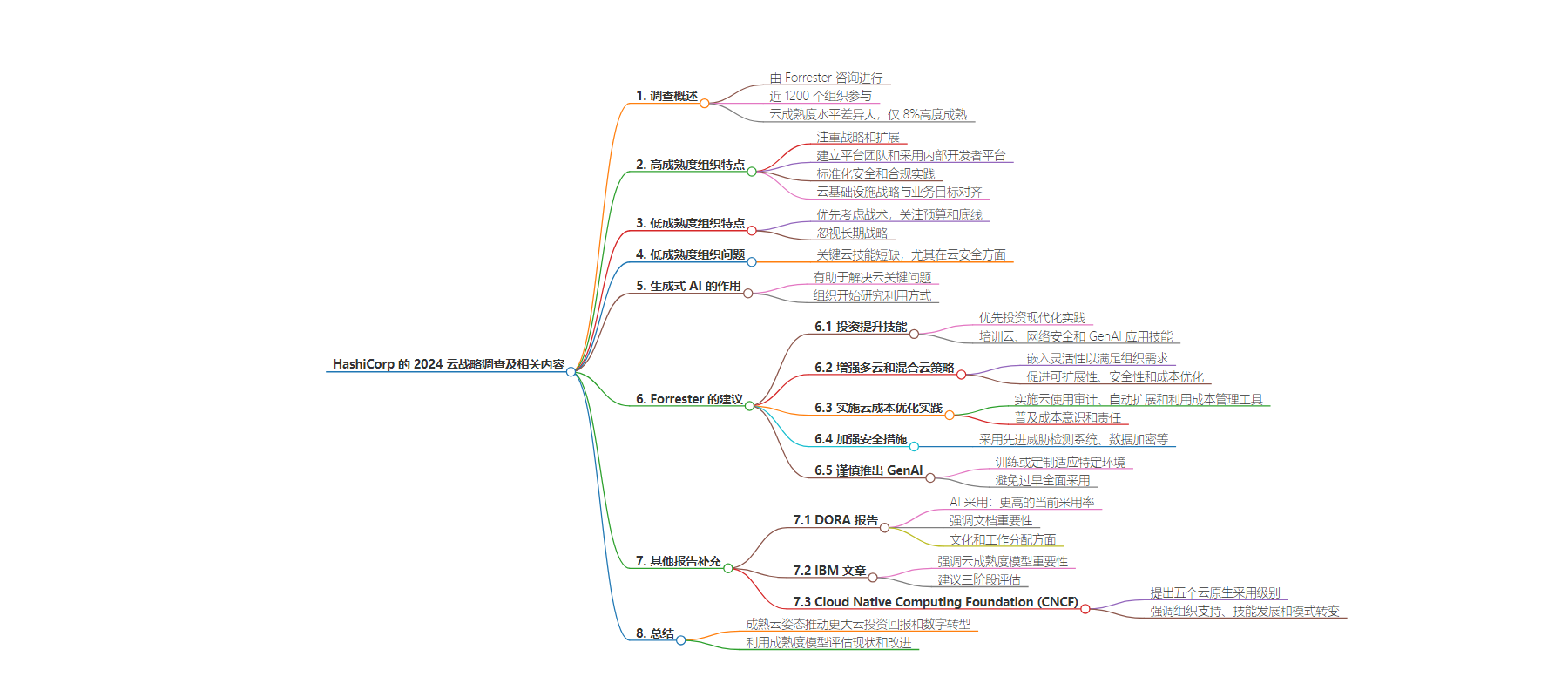包阅导读总结
1.
关键词:HashiCorp、Cloud Maturity、Forrester、Recommendations、Digital Transformations
2.
总结:HashiCorp 的 2024 云战略调查由 Forrester 进行,显示云成熟度差异大。高成熟度组织重战略和扩展,低成熟度组织侧重战术和成本。提出云技能需求、GenAI 应用及多项建议,其他报告提供补充。成熟的云姿态推动更大回报和数字转型。
3.
– HashiCorp 云战略调查
– 由 Forrester 咨询进行,近 1200 个组织参与
– 显示云成熟度水平差距大,仅 8%高度成熟
– 成熟度差异
– 高成熟度组织注重战略和扩展,建立平台团队等
– 低成熟度组织侧重战术,关注预算和底线
– 关键问题与技术
– 低成熟度组织云技能短缺,尤其在云安全方面
– 很多组织认为 GenAI 能助解决云关键问题
– Forrester 建议
– 投资提升技能,培训云、网络安全和 GenAI 应用
– 增强多云和混合云策略,嵌入灵活性
– 实施云成本优化实践
– 加强安全措施
– 谨慎推出 GenAI 用于自动化和创新
– 其他报告补充
– DORA 报告:AI 采用率更高,强调文档重要性等
– IBM 文章:提供云成熟度模型评估框架
– CNCF 成熟度模型:分五级,强调发展进程
思维导图:
文章来源:infoq.com
作者:Matt Saunders
发布时间:2024/8/5 0:00
语言:英文
总字数:796字
预计阅读时间:4分钟
评分:87分
标签:云战略,云成熟度,云安全,云成本优化,生成式 AI
以下为原文内容
本内容来源于用户推荐转载,旨在分享知识与观点,如有侵权请联系删除 联系邮箱 media@ilingban.com
HashiCorp’s 2024 State of Cloud Strategy Survey, conducted by Forrester Consulting, provides critical insights into cloud adoption and maturity among global enterprises. The study surveyed nearly 1,200 organisations, revealing a significant disparity in cloud maturity levels, with only 8% of respondents qualifying as highly cloud mature.
The key findings from Forrester show that high-maturity organisations focus on strategy and scaling. They establish platform teams and adopt internal developer platforms (IDPs) while standardising security and compliance practices across their entire digital estate. They are significantly more likely to align their cloud infrastructure strategy with overall business goals, strengthen security, reduce risk, and simplify compliance.
In contrast, low-maturity firms prioritise tactical considerations. They appear more focused on budgets and bottom lines. Forrester notes this as concerning, indicating that these organisations are paying more attention to short-term cost-cutting than long-term strategy.
The need for essential cloud skills is particularly problematic for low-maturity firms. This shortage creates challenges in many areas, especially in cloud security.
Despite being in its early stages, many respondents believe Generative AI can help address critical cloud issues such as security, skills, availability, and scalability. Organisations are beginning to investigate how to use AI to bolster their cloud infrastructure and security efforts.
Forrester goes on to make several recommendations.
Invest in upskilling: Organisations should prioritise investment in modernising practices like the centralised use of infrastructure as code. Addressing skills gaps through training in cloud, cybersecurity, and GenAI applications is crucial. This approach can attract skilled developers enticed by the promise of working in a modern development environment.
Enhance multi-cloud and hybrid cloud strategy: Forrester advises embedding flexibility into cloud solutions to address specific organisational needs while promoting scalability, improving security, and optimising costs.
Implement cloud cost optimisation practices: to tackle the challenge of avoidable cloud spend (cloud waste), Forrester recommends implementing cloud usage audits, auto-scaling, and leveraging cost management tools. Spreading cost awareness and responsibility across teams can also help reduce cloud waste.
Strengthen security measures: As security remains a top priority across all levels of cloud maturity, organisations should solidify their security posture with advanced threat-detection systems, data encryption, regular security assessments, and ensuring staff is up to date on security best practices.
Carefully roll out GenAI for automation and innovation: While encouraging GenAI technologies to alleviate staffing issues and enhance security, Forrester advises caution. Organisations should make it a strategic objective to train or customise AI to their specific environment to help address skill gaps. However, the study advises against going all-in on AI too soon, noting that current AI solutions may only be ready for some use cases.
While the Forrester report focuses on cloud strategy, the most-recent DORA Accelerate State of DevOps Report (2023) provides additional context in some areas:
On AI adoption, DORA says, “More than half of respondents are already using AI for some technical tasks today, showing moderate improvements to employee well-being.” This suggests a higher current adoption rate than implied by the Forrester report, which describes GenAI as still in the early stages.
DORA also emphasises the importance of documentation, stating that “High-quality documentation leads to 25% higher team performance,” and also highlights cultural and work distribution aspects that aren’t addressed in the Forrester report, noting that teams with generative cultures perform 30% better and that job security can reduce burnout.
Finally, DORA emphasises the importance of focusing on the user, stating that this gives 40% better performance and 20% higher job satisfaction.
IBM’s article on Cloud Maturity Models (CMMs) provides additional context and frameworks for evaluating cloud adoption readiness. The article emphasises the importance of CMMs in addressing concerns around security, governance, and lack of resources and expertise. It suggests a three-phase assessment, cycling through Cloud Adoption Maturity, Cloud Security Maturity and Cloud-Native Maturity.
The IBM article emphasises that organisations may only need to reach the highest level of maturity in some models. However, it notes that some level of cloud maturity is likely necessary to remain competitive, given that 70% of workloads are expected to be on the cloud by 2024, according to Gartner.
The Cloud Native Computing Foundation (CNCF) also has a maturity model, outlining five levels of cloud-native adoption: Build, Operate, Scale, Improve and Optimise.
Each level represents increased cloud-native integration, from initial proof of concept to a fully optimised, flexible platform. The model emphasises the progression of organisational support, skill development, and the shift from centralisation to decentralisation as maturity increases.
The reports all highlight that more mature cloud postures drive more significant cloud ROI, and improve digital transformations. As organisations progress in their cloud journey, they can use these maturity models to assess their current state, identify areas for improvement, and develop strategies to maximise the benefits of cloud adoption while addressing key challenges such as security, cost optimisation, and skills development.
